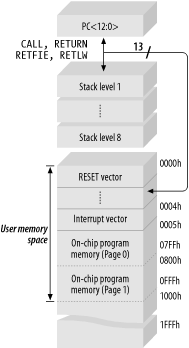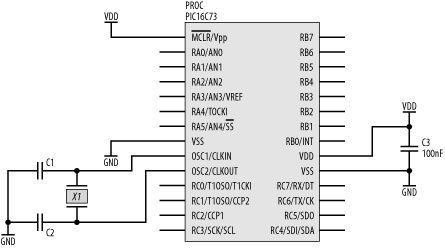A Bigger PIC
In this section, we’ll look at the PIC16C73 processor. For a midrange PIC, the design is not dissimilar to the simpler PIC we’ve already looked at. The only real difference is that the processor has more pins, more I/O, and more functionality. We’ll look at what you can do with its various I/O subsystems in Part III of this book.
The address space for this processor is shown in Figure 5-6.

Figure 5-6. PIC16C73 address space (Reference: PIC16C73 datasheet)
The schematic for this processor is shown in Figure 5-7. This processor has 4K words of program memory, 192 bytes of RAM, and a variety of I/O subsystems, such as three timer modules, SPI, I2C, a UART, five channels of analog input, and up to 22 digital I/O pins.

Figure 5-7. PIC16C73 processor and support components
This processor has one power pin (VDD) and two ground pins (VSS). As always, power is decoupled to ground with a small capacitor (C3). The only other requirements are some form of clock generation, in this case provided by a crystal, X1, and two decoupling capacitors, C1 and C2. The clock could just as easily have been provided using an RC circuit, as we saw with the 12C508. The reset input, MCLR , is tied directly to the power supply, so that is permanently inactive. In this case, we are relying on the processor’s ...
Get Designing Embedded Hardware now with the O’Reilly learning platform.
O’Reilly members experience books, live events, courses curated by job role, and more from O’Reilly and nearly 200 top publishers.

